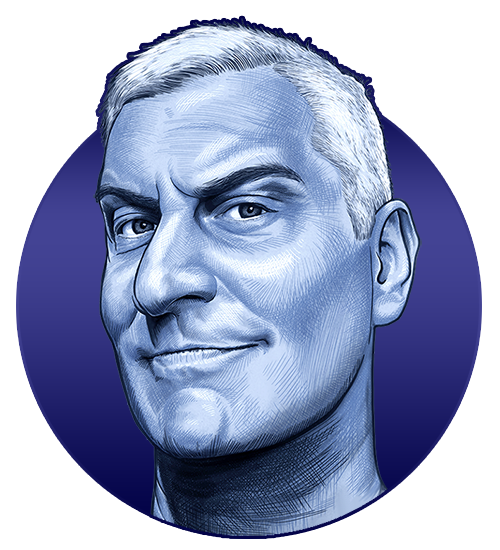WHY?

Dear visitor,
You would like to know what’s behind it?
Then without further ado:
Why portrait?
Because I consider it to be a very demanding genre.
On the one hand from a purely technical point of view: The task of the portrait is to depict a person. That is not without its difficulties, as a sufficient similarity of the work with this person is required. To what extent this is fulfilled can be judged, by the way, without any artistic expertise. One recognizes the person better or worse.
On the other hand, from a philosophical point of view: For people, ultimately everything revolves around dealing with other people. The better you understand the nature and motivation of your counterpart, the more successful you will interact. The ultimate goal: The better you understand the nature and motivation of your counterpart, the better you understand yourself.
I try to provide these two components, recognition and something of the essence of the model, to the best of my ability.
Why „Icons of Pop Culture“?
Because… I’ll break it down for you a bit.
Obvious reason: The person depicted has touched me in some way. Or impressed. Or fascinated. So much so that I am willing and able to spend hours and days with her by drawing her.
Analytical reason: People tend to reduce a celebrity to a projection surface for personal views; as an ideal, as a symbol or even as a scapegoat. And, of course, that never does justice to the true essence of the target person. Of course, I don’t get to know anyone by drawing them. But be sure, with every hour that I explore a face, I discover new nuances that change the first superficial impression more or less strongly. And, curse or blessing, the longer I look at a face, the more empathy I am willing to develop for it.
Practical reason: To portrait a face, views from different angles are helpful. Also different facial expressions. And if it’s an „icon“, you will find usable reference images on the internet with great certainty. It’s more difficult for completely unknown people, like Cordula Pepschmier, Gaspode P. Flanger or Kermit Bibberson.
User-friendly reason: With a celebrity, all viewers have a similarly good starting point to evaluate the result. That would not be possible for an unknown face.
Why caricatured?
The representation of a human face is initially a portrait, painted or photographed. If the client is also the person being portrayed, there is likely a representative purpose behind it. That is to say, the person being portrayed wants to make the best possible impression on the viewers of the picture. The maker of the portrait aims to fulfill this wish, because satisfied customers recommend the next customers. So he puts his client, for example, in a favorable diffused light that gently softens the wrinkles; or he places him in a room so that 40 kilograms of overweight disappear behind a stage prop; and for the final touch, there’s some Photoshop. So far, so understandable.
Such a portrait is therefore not only not a caricature, but more or less embellished, even by reducing, avoiding, or removing unflattering features.
A snapshot is a kind of opposite of the posed portrait, but it is also incomplete: Since it is a spontaneous snapshot, the sum, the interaction of all circumstances at the moment of the shot is highly probable unique, and yet this image probably allows more than one interpretation; that is initially neither good nor bad, but simply not more objective than the posed portrait.
From these two distinct examples, it becomes clear that different perspectives, different forms of representation also produce different perceptions.
Basically, no artistic representation can be more than just a rough approximation of the essence of the person being represented, because of course it requires some other cognitive means. Otherwise, we only see what we want to see; and we want to see it because we expect it.
This conclusion may seem obvious at first glance; yet the photo for many of us has the aura of incorruptible objectivity, because we expect it to show only the truth and nothing but the truth. But not the whole truth.
I strive for the caricature to achieve the most „objective truthfulness“ of representation. Paradoxically, my most important tool for this is exaggeration, which is subjective by its nature. Because all the sizes of a face are objectively measurable in millimeters, any deviation from these measurements, any exaggeration is in the subjective discretion of the artist.
I therefore define shape and expression subjectively and thereby create an objective similarity to the person being depicted, while at the same time emphasizing certain aspects of the person.
Just like a portrait with an explicitly serious claim, the caricature is a particularly pronounced representation that creates a certain perception. Only the viewer is presented with the special expression of the caricature, namely exaggeration, unmistakably, so he can consciously see it with this reservation in mind. On the other hand, the viewer expects objectivity from the photo, which can hardly be achieved.
Since I portray people from public life, all viewers have a similarly good starting point to evaluate the result. This would not be possible for an unknown face. Ideally, the viewer can even more easily associate the caricature with a person X than the actual sight of person X himself. This is less strange than it reads: When we encounter people in an unusual context, it is not uncommon for us to recognize them only on the second glance.
Why Ballpoint Pen?
I’m glad you’re asking. The ballpoint pen is so ubiquitous and everyday, so banal and unartistic: It can hardly be further from an old master technique. Even Rembrandt would have only written his shopping list with a ballpoint pen. Or jotted down an email address.
In the mid-nineties, I discovered that surprisingly detailed drawings could be produced with a cheap BIC pen. The reason I didn’t pursue this technique further was the huge effort in time and concentration. Because the ballpoint pen does not forgive anything…
For caricatures, I switched to digital illustration for purely pragmatic reasons. You draw directly on a touch-sensitive screen in the computer.
On the one hand, this opens up infinite new possibilities for painting hyperrealistically; to reproduce, license and deliver quickly and easily. On the other hand, there is no original anymore.
And so I came back to the ballpoint pen, because:
I want the work to show that it has taken time, craftsmanship and effort; and passion, attention to detail, and connection to the subject.
I want the work to show that it was not obtained by a user with a free app on a smartphone; who doesn’t care what kind of time-waste he’s taking on: Cat-content or an app that pretends to be creative.
That’s why the ballpoint pen.
Why you?
You know better than I 🙂 Nice to have you here.
Möchten Sie den Katalog?
Schreiben Sie mir.
Dann bekommen Sie Links zum Herunterladen der PDFs.
Eines für Kugelschreiber und eines für Buntstift.
Mit Preisen.


